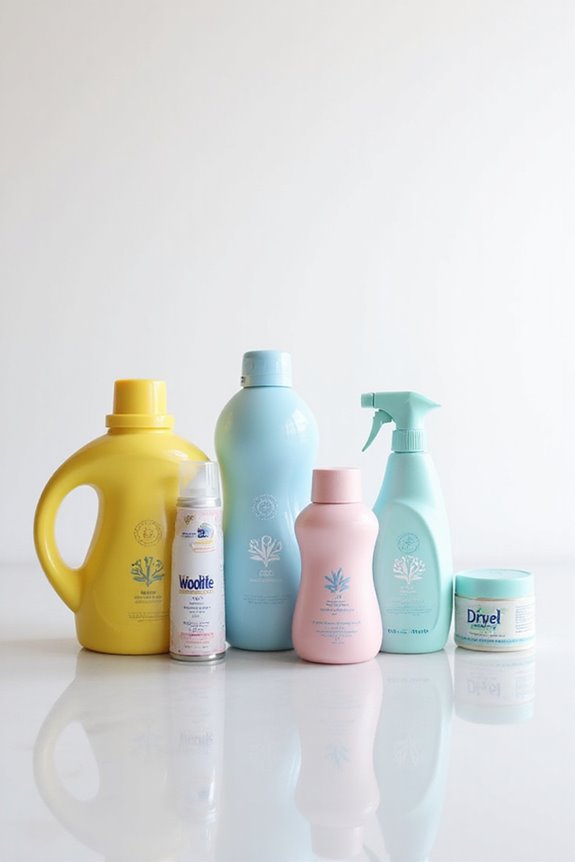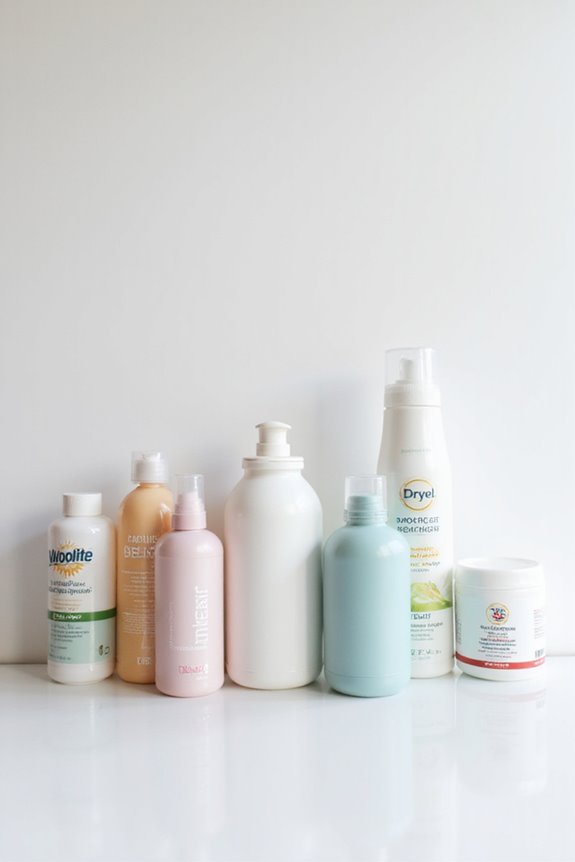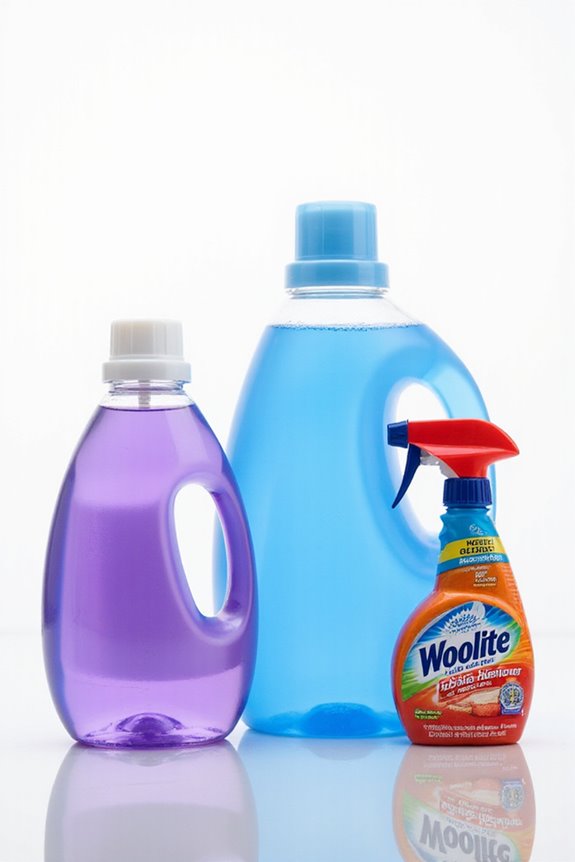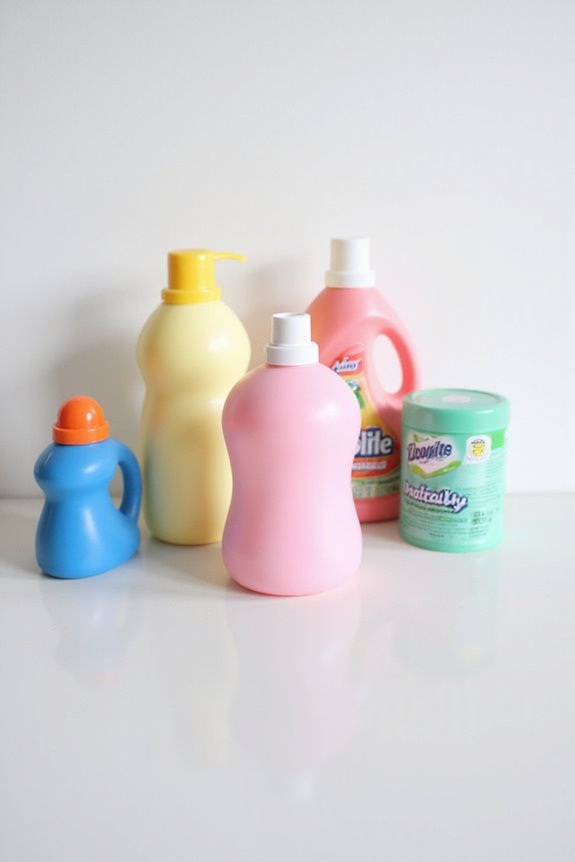Using fabric softener in every wash isn’t always the best idea. It can harm certain fabrics, like towels and athletic wear, by reducing their absorbency. Plus, it might cause buildup in our washing machines, making them less efficient and leading to odors. It’s wise to choose wisely when to use it, based on the fabric type. So, let’s explore how to keep our laundry fresh and soft without any hitches along the way.
Key Takeaways
- Fabric softener is not suitable for all fabrics, particularly water-repellent or flame-retardant items.
- Frequent use may reduce towel absorbency and shorten the lifespan of clothes.
- Chemicals in softeners can irritate sensitive skin and trigger allergic reactions.
- Overuse can lead to residue buildup in washing machines, affecting efficiency.
- Consider alternatives like dryer balls or vinegar, and assess the need for softener based on fabric type.
Understanding Fabric Softener and Its Purpose
When we do laundry, we often want our clothes to feel soft and smell fresh, and that’s where fabric softener comes in. This handy product conditions our fabrics, reducing static cling and wrinkles while adding a pleasant scent. The fabric softener benefits don’t stop there; it also protects fibers from wear and tear and helps prevent pilling, keeping our clothes looking fresh longer. However, there are some fabric softener misconceptions. Not every fabric needs it, especially those labeled as water-repellent or flame-retardant. So, we should always check care labels. While fabric softener enhances comfort and freshness, using it wisely can extend the life of our favorite items. It’s all about balance—softness without the hassle! Additionally, for those with sensitive skin, it’s crucial to consider hypoallergenic formulations to avoid potential irritation.
The Impact of Fabric Softener on Washing Machines
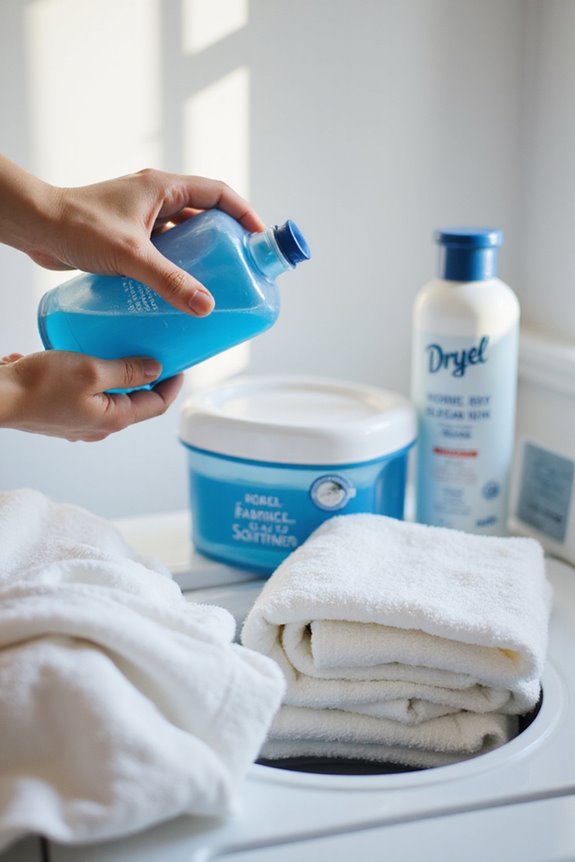
Fabric softeners can make our laundry feel softer and smell great, but they can also create some unexpected challenges for our washing machines. Over time, we might notice residue buildup from fabric softener that can clog dispensers and internal pipes. This residue can reduce our machine’s efficiency, making it harder for water and detergent to flow freely. Plus, if we’re not careful, we could end up with unpleasant odors in our machines. Regular cleaning of the detergent drawer and softener compartment can help prevent these issues. To keep our machines running smoothly, let’s be mindful of how much fabric softener we use and consider alternatives like white vinegar. It’s a small step that can save us from bigger problems down the road! Additionally, using eco-friendly options reduces the risk of buildup from harsh chemicals that may further complicate machine maintenance.
Effects on Different Types of Fabrics
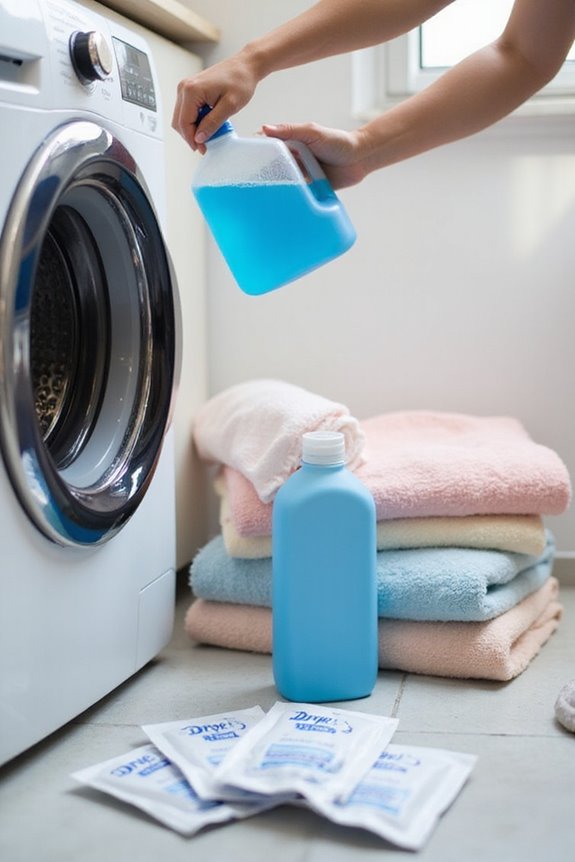
While we all love the idea of our clothes feeling soft and smelling fresh, using fabric softener can have some surprising effects on different types of fabrics. For instance, cotton fabrics might feel nice initially, but over time, they can lose strength and absorbency. Natural fibers, like wool, can become matted and less breathable.
On the other hand, synthetic fabrics, especially athletic wear, can face absorbency issues, making them less effective at wicking moisture. Plus, fabric softeners can compromise flame resistance in specialized fabrics. Microfiber efficiency also takes a hit, reducing cleaning power when coated with softeners. Additionally, certain laundry detergents designed for pet hair removal can enhance cleaning efficiency and maintain fabric quality. So, next time we reach for that bottle, let’s think about how it impacts our favorite clothes!
Health Considerations Related to Fabric Softener

Using fabric softener might seem like a harmless way to make our clothes feel softer and smell fresher, but it’s essential to reflect on the health implications that come with it. Many of us don’t realize that fabric softeners can pose health risks, especially for those with sensitive skin. They often lead to allergic reactions, causing itchy or inflamed skin. Plus, the chemicals in these products can trigger asthma and respiratory issues. It’s alarming that one in ten children with asthma might be affected by these compounds! So, if we have kids or anyone with skin sensitivities in our home, we should think twice before reaching for that bottle of fabric softener. Our health is worth the extra consideration! Additionally, using hypoallergenic detergents can minimize these risks while still providing effective cleaning.
When to Use Fabric Softener for Optimal Results

When we’re doing laundry, knowing the right time to add fabric softener can make a big difference in how our clothes turn out. For ideal timing, we should always add fabric softener during the rinse cycle. This is when it works best, as it’s diluted in water, allowing it to cling to our fabrics effectively. Remember, each washing machine type has specific guidelines for using fabric softener, so we should check those. Also, let’s adjust the amount based on our load size—about a quarter to half a capful usually does the trick. And hey, be careful not to add it midway through the wash; that just doesn’t work! Additionally, using a fabric softener can help reduce static cling and keep our clothes looking fresh. So, let’s keep our clothes soft and fresh!
Limitations and Risks of Frequent Use
Frequent use of fabric softener might seem like a good idea for keeping our clothes feeling soft and fresh, but there are some important limitations and risks we should consider. For one, many fabric softeners contain chemicals that can irritate our skin or trigger allergies. If we’re sensitive or have kids, this is definitely something to think about. Plus, the chemicals can affect our respiratory health, especially when we dry our clothes. On top of that, using fabric softener too often can reduce the absorbency of towels and even shorten the life of our clothes. And let’s not forget the environmental impact—most of these softeners aren’t biodegradable, harming our waterways. So, moderation is key! Additionally, many experts recommend hypoallergenic options to minimize skin irritation and allergic reactions.
Maintenance Tips for Washing Machines
Maintaining our washing machines is just as important as washing our clothes. Regular washing machine maintenance can save us from headaches later. We should clean the washer drum and dispensers monthly to prevent residue buildup. It’s also crucial to inspect hoses for cracks or leaks every month. Trust me, replacing those hoses every few years is worth it to avoid water damage.
Let’s not overload our machines; they need space to clean effectively. And remember, leaving the door open after washes helps prevent mold. By taking these simple steps, we can extend our appliance longevity and guarantee our washing machines serve us well for years to come. A little effort goes a long way!
Alternative Methods to Achieve Softness
After we’ve taken care of our washing machines, it’s time to think about how to keep our clothes soft and fresh. We can explore natural alternatives to traditional fabric softeners. Wool dryer balls are a fantastic eco-friendly option; they reduce drying time and soften fabrics without chemicals. Another great choice is white vinegar, which breaks down detergent residues and neutralizes odors. Baking soda works wonders too, softening our laundry while regulating pH levels. If we toss in a damp towel or some tennis balls during drying, we can cut down on static cling, too. These methods are not just better for our clothes, but they’re also kinder to the planet. Who knew laundry could be so simple?
Making the Right Choice for Your Laundry Needs
How do we decide which fabric softener is right for our laundry needs? First, we should consider the fabric softener benefits, like reducing static cling and making clothes feel softer. If we love fluffy towels, a softener can help without sacrificing absorbency. But let’s not forget our laundry preferences! For delicate items, we might skip the softener to protect those fibers.
It’s also smart to check if our washing machine can handle certain types of softeners, like liquid or dryer sheets, without causing buildup. And remember, using too much can lead to residue. So, let’s choose wisely and test a few options to find what suits our needs best! After all, nobody wants crispy clothes, right?
Frequently Asked Questions
Can Fabric Softener Be Used With All Types of Fabrics?
Imagine washing our favorite wool sweater. While fabric softener can enhance softness, we should avoid it on delicate fabrics. For synthetic blends, it’s effective, but we must be cautious to maintain their performance.
Does Fabric Softener Affect the Drying Time of Laundry?
We’ve noticed that fabric softener can enhance drying efficiency by reducing moisture retention in fabrics. It makes them smoother, allowing for quicker drying times, especially in tumble dryers, which can save energy and boost overall efficiency.
Can I Mix Fabric Softener With Other Laundry Products?
Mixing fabric softener with other laundry products is like trying to blend oil and water; the interactions can cause residue buildup and reduce effectiveness. We should guarantee laundry product compatibility for the best results in our washes.
How Much Fabric Softener Should I Use per Load?
When it comes to fabric softener measurements, we should follow load size guidelines. For small loads, use about 1/8 cup; for standard loads, 1/4 to 1/2 cup works best. Let’s measure carefully!
Is It Safe to Use Fabric Softener on Baby Clothes?
When it comes to baby skin and fabric allergies, we should prioritize safety over softness. Let’s choose gentle, hypoallergenic alternatives and avoid fabric softeners that may irritate or harm our little ones’ delicate skin.

